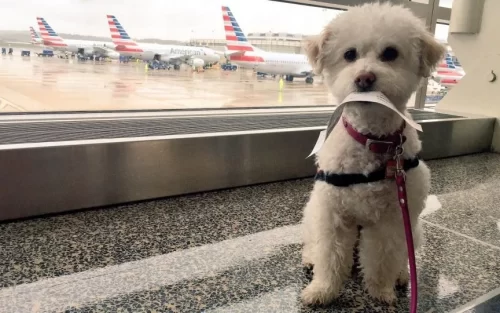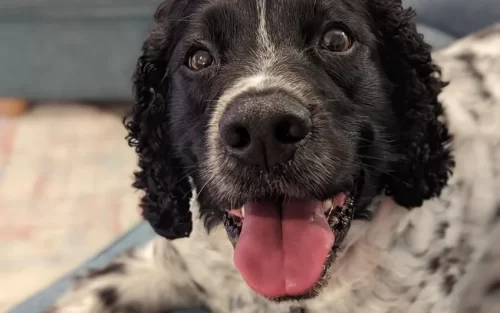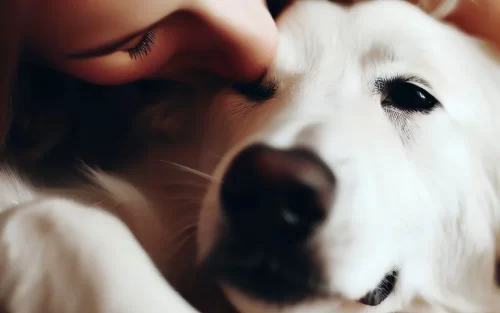Tail wagging is one of the most recognizable forms of canine communication. As dog owners, we often associate it with happiness, but have you ever wondered if there’s more to it than just a simple wag? Why do dogs wag their tails? In reality, tail wagging can convey a wide range of emotions and messages. By understanding the nuances of this unique form of body language, we can deepen our bond with our four-legged friends and better respond to their needs.
In this comprehensive guide, we will delve into the fascinating world of canine tail wagging, exploring its underlying science, the various meanings it can convey, and how it plays a crucial role in social interactions between dogs. We will also discuss the importance of breed-specific tail characteristics, offer tips for interpreting your dog’s tail movements, and explain how this knowledge can improve training and strengthen your bond with your furry companion.
Whether you’re a seasoned dog owner or a new pet parent, this article aims to help you decode the subtle language of tail wagging, fostering a more harmonious relationship with your beloved canine companion. So, join us as we unravel the mystery behind one of the most captivating aspects of dog behavior – tail wagging.
The Science Behind Tail Wagging
Before we dive into the meanings of tail wagging, it’s essential to understand the science and anatomy behind this fascinating canine behavior. A dog’s tail is an extension of its spine, consisting of several vertebrae called the caudal vertebrae. These vertebrae are surrounded by muscles, tendons, and nerves, which work together to control tail movement.
At the base of the tail, a group of muscles called the caudal muscles is responsible for the wagging motion. These muscles receive signals from the dog’s nervous system, specifically from the spinal cord, which in turn receives input from the brain. When a dog’s brain processes emotions or social cues, it sends signals to the spinal cord, which then stimulates the caudal muscles, causing the tail to wag.
The wagging itself is a complex interplay between various muscle groups. The contraction of one group of muscles on one side of the tail will cause it to move in one direction, while the relaxation of those muscles and the contraction of the opposing group will move the tail in the opposite direction. The speed and direction of the wagging are determined by the intensity and frequency of the nerve signals sent from the brain.
In addition to its role in communication, a dog’s tail also serves other essential functions, such as maintaining balance while running or navigating tight spaces. It can even act as a rudder when dogs swim. Understanding the science behind tail wagging allows us to appreciate not only its significance in communication but also the remarkable adaptability and versatility of our canine companions. Armed with this knowledge, we can now delve into the various meanings and messages that tail wagging can convey.
The Many Meanings of Tail Wagging
Tail wagging is a versatile form of communication that can express a wide range of emotions and messages. To accurately interpret what your dog is trying to convey, it’s essential to consider the context, overall body language, and the specific wagging pattern. Here are some common meanings behind tail wagging:
- Happiness or excitement: This is perhaps the most well-known meaning of tail wagging. A dog with a loose, relaxed body and an energetically wagging tail, often accompanied by a playful or friendly demeanor, is likely expressing happiness or excitement. This wagging usually occurs at a moderate to high speed and may involve the entire rear end.
- Nervousness or submission: A dog displaying submissive behavior may wag its tail low or even tucked between its legs, often with slow, tentative movements. This can indicate that the dog is feeling nervous, uncertain, or submissive, especially when accompanied by other submissive body language cues like lowered ears, averted gaze, or crouching posture.
- Fear or anxiety: Anxious or fearful dogs may also exhibit a low or tucked tail wag, but the wagging may be faster and more erratic. Signs of fear or anxiety, such as lip licking, panting, or trembling, can help differentiate this from submissive tail wagging.
- Aggression or warning: A stiff, slow, and deliberate wag, often with the tail held high or horizontally, can signal aggression or a warning. This type of wagging is typically accompanied by tense body language, bared teeth, or growling, indicating that the dog feels threatened or is asserting dominance.
Understanding the various meanings of tail wagging allows us to better empathize with our dogs and respond to their emotional states more effectively. Remember that context and overall body language are crucial factors in accurately interpreting your dog’s tail movements, ensuring clear communication and a stronger bond with your furry companion.
Wagging Direction and Speed: Subtle Clues to Your Dog’s Emotions
The direction and speed of tail wagging can provide subtle yet valuable insights into your dog’s emotional state. By paying close attention to these cues, you can gain a deeper understanding of your dog’s feelings and intentions. Here are some wagging patterns and their associated meanings:
- Rightward wagging: Research suggests that when dogs wag their tails more to the right side of their body, they are likely experiencing positive emotions, such as happiness, relaxation, or friendliness. This rightward bias may be more pronounced when they see their owner or another familiar, friendly individual.
- Leftward wagging: Conversely, dogs tend to wag their tails more to the left side of their body when they are experiencing negative emotions, such as fear, anxiety, or aggression. A leftward wagging bias could indicate that your dog is feeling uneasy or threatened in a particular situation.
- Fast wagging: Rapid tail wagging is often a sign of high energy, excitement, or enthusiasm. However, it’s essential to consider the context and other body language cues, as fast wagging may also indicate anxiety or agitation in some cases.
- Slow wagging: A slow, gentle wag usually suggests that the dog is relaxed or content. However, if the tail is held stiffly and wagged slowly, it could be a sign of caution or uncertainty. As always, observing the overall body language and context is crucial for accurate interpretation.
By paying attention to the direction and speed of your dog’s tail wagging, you can better understand their emotions and respond accordingly. This increased awareness can lead to improved communication, a stronger bond, and a more harmonious relationship with your canine companion.
Breed-Specific Tail Characteristics and Wagging
Different dog breeds exhibit unique tail shapes and wagging styles due to their genetics and physical characteristics. These breed-specific traits can influence how we interpret tail wagging, making it essential to consider your dog’s breed when decoding their tail movements. Here are some examples of breed-specific tail characteristics and wagging:
- Curly tails: Breeds like Pugs, Shiba Inus, and Akita Inus have curly tails that can make it challenging to determine the exact direction of the wagging. For these breeds, focus on the base of the tail and observe the overall body language to get a better understanding of their emotions.
- Short or docked tails: Some breeds, like Boxers, Rottweilers, or Doberman Pinschers, have naturally short or docked tails. In such cases, it may be harder to observe wagging patterns. Paying attention to other body language cues, such as ear position, facial expressions, and body posture, becomes even more critical for accurate interpretation.
- Long, bushy tails: Breeds like Golden Retrievers, Border Collies, or German Shepherds have long, bushy tails that can wag more visibly. Their wagging may be more expressive and easier to read, but it’s still crucial to consider the context and overall body language.
- Tails with unique markings: Some breeds, like the Beagle or the Bernese Mountain Dog, have distinct tail markings that can draw attention to their wagging. This can make it easier for owners to notice and interpret their dog’s tail movements.
Understanding how your dog’s breed-specific tail characteristics impact their wagging can help you better interpret their emotions and intentions. Keep these breed-specific traits in mind when observing your dog’s tail wagging, and remember that context and overall body language remain vital factors in decoding your dog’s messages.
Tail Wagging in Social Interactions: How Dogs Communicate with Each Other
Tail wagging plays a significant role in dog-to-dog communication, helping canines establish hierarchy, maintain social harmony, and convey various messages within their social groups. Here’s how dogs use tail wagging to communicate with each other:
- Greeting rituals: When dogs meet for the first time or greet familiar friends, tail wagging serves as a friendly gesture that can help diffuse tension and promote positive interactions. Typically, dogs engaged in a friendly greeting will exhibit relaxed body language, with tails wagging at a moderate speed and height.
- Establishing hierarchy: In a pack or social group, dogs use tail wagging to display their social status. Dominant dogs may hold their tails higher, wagging them slowly and deliberately, while submissive dogs may keep their tails lower or even tucked, with slow or fast wagging, depending on the situation.
- Calming signals: Dogs may use tail wagging as a calming signal to communicate their intentions and alleviate tension in potentially stressful situations. For example, a dog that feels threatened or unsure may wag its tail low or tucked, signaling submission and a desire to avoid conflict.
- Play invitations: In a playful context, dogs often use tail wagging as an invitation for others to join in the fun. This type of wagging is usually accompanied by a play bow, where the dog lowers its front half while keeping its rear end and tail elevated, signaling that they are ready for some friendly roughhousing.
Understanding the role of tail wagging in dog-to-dog communication can help you better manage your dog’s social interactions and prevent conflicts. By observing how your dog uses tail wagging to communicate with other dogs, you can gain valuable insights into their social behavior and dynamics, ensuring a safer and more enjoyable experience for everyone involved.
How to Interpret Your Dog’s Tail Wagging and Improve Training
Being able to accurately interpret your dog’s tail wagging can not only enhance your bond but also improve training outcomes. By understanding your dog’s emotional state through their tail movements, you can tailor your training approach and create a more positive learning environment. Here are some tips to help you make the most of your dog’s tail wagging cues during training:
- Observe the context: Always consider the situation and your dog’s overall body language when interpreting their tail wagging. This will help you better understand their emotions and adjust your training methods accordingly.
- Provide positive reinforcement: When you see your dog wagging their tail in a happy, relaxed manner, reward them with praise, treats, or playtime. This positive reinforcement encourages desired behaviors and fosters a stronger bond.
- Address anxiety and fear: If your dog’s tail wagging indicates anxiety or fear, take a step back and assess the situation. Adjust your training approach to help your dog feel more comfortable and confident, and consider seeking guidance from a professional dog trainer if needed.
- Monitor social interactions: During group training sessions or playdates, observe how your dog uses tail wagging to communicate with other dogs. This can help you identify potential issues and intervene before conflicts arise, ensuring a positive experience for all involved.
- Consistency and patience: As with any aspect of dog training, consistency and patience are key. Regularly observe your dog’s tail wagging and practice interpreting their emotions to improve your communication skills and enhance your bond over time.
By incorporating your understanding of tail wagging into your training approach, you can create a more effective and empathetic learning environment for your canine companion. This, in turn, will lead to a more harmonious relationship and a happier, well-adjusted dog.
Strengthening Your Bond with Your Dog through Tail Wagging Communication
Interpreting your dog’s tail wagging is more than just understanding their emotions; it’s a vital aspect of building a strong bond with your furry friend. By paying attention to their tail movements and responding appropriately, you can foster a relationship built on trust, empathy, and mutual understanding. Here are some tips to strengthen your bond with your dog through tail wagging communication:
- Be observant: Take the time to watch your dog’s tail movements in various situations, and familiarize yourself with their unique wagging patterns. This will help you become more attuned to their emotional state and better equipped to respond to their needs.
- Empathize with your dog: When you notice changes in your dog’s tail wagging, try to empathize with how they might be feeling. This can help you develop a deeper connection with your pet and enhance your ability to provide comfort and support when needed.
- Adapt your behavior: Once you understand your dog’s tail wagging cues, adjust your behavior accordingly. For example, if your dog’s wagging indicates that they’re feeling anxious, provide reassurance and create a calmer environment to help them feel more at ease.
- Encourage positive interactions: Use your understanding of tail wagging to promote positive interactions between your dog and other dogs or people. This can help to improve your dog’s social skills and build their confidence in different situations.
- Celebrate your dog’s uniqueness: Every dog has its unique wagging patterns and communication style. Embrace these differences and celebrate your dog’s individuality, strengthening the bond between you and your one-of-a-kind canine companion.
By focusing on tail wagging communication and fostering an empathetic understanding of your dog’s emotions, you can build a strong, lasting bond with your pet. This relationship will not only enrich your life but also provide your dog with the love, support, and guidance they need to thrive.
The Evolution of Tail Wagging: How and Why It Developed in Dogs
Tail wagging has evolved as an essential communication tool for dogs, enabling them to express their emotions and intentions in a variety of situations. But how and why did this form of communication develop in our canine companions? Let’s explore the evolutionary origins of tail wagging in dogs:
- Ancestral origins: The ancestors of modern dogs, wolves, also use tail movements to communicate within their social groups. Wolves rely on their tails to convey information about their social status, emotional state, and intentions, similar to how dogs use tail wagging today. This suggests that tail wagging in dogs has deep evolutionary roots, with its origins in their wild ancestors.
- Domestication and selective breeding: As humans began domesticating dogs, tail wagging likely became an increasingly important means of communication between dogs and their human caretakers. Selective breeding for specific traits, such as friendly temperament and responsiveness to human cues, may have led to the development of more expressive and varied tail wagging patterns in dogs.
- Adaptation for survival: Tail wagging as a form of communication may have also evolved as a survival mechanism for dogs. By conveying their emotions and intentions clearly to other dogs and humans, dogs can navigate social situations more effectively, build strong relationships, and ultimately increase their chances of survival.
- Social communication: Dogs are highly social animals, and tail wagging provides them with a means to maintain social harmony and avoid conflicts within their social groups. This form of communication enables dogs to negotiate social hierarchies, establish boundaries, and express their emotions in a way that promotes group cohesion and cooperation.
Understanding the evolutionary origins of tail wagging helps us appreciate the deep-rooted importance of this form of communication in our canine companions. By recognizing the role tail wagging plays in our dogs’ lives, we can become more empathetic and attuned to their needs, fostering a stronger bond and enhancing our shared experiences.
Conclusion
Tail wagging is an essential form of communication for dogs, allowing them to express their emotions and intentions to both humans and other dogs. By understanding the various factors that influence tail wagging, such as direction, speed, and breed-specific characteristics, dog owners can become more in tune with their pets’ emotional states and strengthen their bond. Moreover, acknowledging the scientific findings and evolutionary origins of tail wagging enhances our appreciation for the complex emotional lives of our canine companions.
As a dog owner, it’s crucial to pay close attention to your pet’s tail movements and overall body language to decipher their emotions accurately. This understanding can lead to improved training outcomes, better social interactions, and a deeper connection between you and your furry friend. By fostering a relationship built on trust, empathy, and communication, you can ensure a happier and more fulfilling life for both you and your beloved pet.



